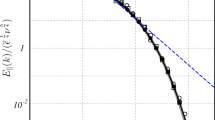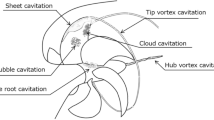Abstract
Wind turbines operate in the surface layer of the atmospheric boundary layer, where they are subjected to strong wind shear and relatively high turbulence levels. These incoming boundary layer flow characteristics are expected to affect the structure of wind turbine wakes. The near-wake region is characterized by a complex coupled vortex system (including helicoidal tip vortices), unsteadiness and strong turbulence heterogeneity. Limited information about the spatial distribution of turbulence in the near wake, the vortex behavior and their influence on the downwind development of the far wake hinders our capability to predict wind turbine power production and fatigue loads in wind farms. This calls for a better understanding of the spatial distribution of the 3D flow and coherent turbulence structures in the near wake. Systematic wind-tunnel experiments were designed and carried out to characterize the structure of the near-wake flow downwind of a model wind turbine placed in a neutral boundary layer flow. A horizontal-axis, three-blade wind turbine model, with a rotor diameter of 13 cm and the hub height at 10.5 cm, occupied the lowest one-third of the boundary layer. High-resolution particle image velocimetry (PIV) was used to measure velocities in multiple vertical stream-wise planes (x–z) and vertical span-wise planes (y–z). In particular, we identified localized regions of strong vorticity and swirling strength, which are the signature of helicoidal tip vortices. These vortices are most pronounced at the top-tip level and persist up to a distance of two to three rotor diameters downwind. The measurements also reveal strong flow rotation and a highly non-axisymmetric distribution of the mean flow and turbulence structure in the near wake. The results provide new insight into the physical mechanisms that govern the development of the near wake of a wind turbine immersed in a neutral boundary layer. They also serve as important data for the development and validation of numerical models.

















Similar content being viewed by others
References
Adrian RJ, Christensen KT, Liu ZC (2000) Analysis and interpretation of instantaneous turbulent velocity fields. Exp Fluids 29:275–290
Ainslie JF (1988) Calculating the flow field in the wake of wind turbines. J Wind Eng Ind Aerodyn 27:213–224
Athanassiadou M, Castro IP (2001) Neutral flow over a series of rough hills: a laboratory experiment. Boundary Layer Meteorol 101:1–30
Bingöl F, Mann J, Larsen GC (2007) Laser measurements of wake dynamics. The proceedings at EWEC, Milan
Bruun HH (1995) Hotwire anemometry, principles and signal analysis. Oxford University Press, UK
Burton T, Sharpe D, Jenkins N, Bossanyi E (2001) Wind energy handbook. 1st edn. Wiley, New York
Cal RB, Lebrón J, Castillo L, Kang HS, Meneveau C (2010) Experimental study of the horizontally averaged flow structure in a model wind-turbine array boundary layer. J Renew Sustain Energy 2:013–106
Carper MA, Porté-Agel F (2008) Subfilter-scale fluxes over a surface roughness transition. Part I: measured fluxes and energy transfer rate. Boundary Layer Meteorol 126:157–179
Chamorro LP, Porté-Agel F (2009) A wind-tunnel investigation of wind-turbine wakes: Boundary-layer turbulence effects. Boundary Layer Meteorol 132(1):129–149
Chamorro LP, Porté-Agel F (2010) Thermal stability and boundary-layer effects on wind-turbine wakes: a wind-tunnel study. Boundary-Layer Meteorol 136:515–533
Crespo A, Hernandez J, Frandsen S (1999) Survey of modelling methods for wind turbine wakes and wind farms. Wind Energy 2:1–24
Dobrev I, Maalouf B, Troldborg N, Massouh F (2008) Investigation of the wind turbine vortex structure. In: 14th international symposium on applications of laser techniques to fluid mechanics, Lisbon, Portugal
Gong W, Ibbetson A (2009) A wind-tunnel study of turbulent flows over model hills. Boundary-Layer Meteorol 49:113–148
Grant ALM (1992) The structure of turbulence in the near-neutral atmospheric boundary-layer. J Atmos Sci 49:226–239
Grant I, Parkin P (2000) A DPIV study of the trailing vortex elements from the blades of a horizontal axis wind turbine in yaw. Exp Fluids 28:368–376
Grant I, Parkin P, Wang X (1997) Optical vortex tracking studies of a horizontal axis wind turbine in yaw using laser-sheet, flow visualisation. Exp Fluids 23:513–519
Hancock PE, Pascheke F (2010) Wind tunnel simulations of wind turbine wake interactions in neutral and stratified wind flow. In: 10th EMS annual meeting, 10th European Conference on Applications of Meteorology (ECAM) Abstracts, September 13–17, 2010 in Zurich, Switzerland
Hansen AC, Butterfield CP (1993) Aerodynamics of horizontal-axis wind turbines. Annu Rev Fluid Mech 25:115–149
Hutchins N, Nickels TB, Marusic I, Chong MS (2009) Hot-wire spatial resolution issues in wall-bounded turbulence. J Fluid Mech 635:103–136
Jorgensen FE (1996) The computer-controlled constant temperature ameometer: aspectes of the set-up, probe calibration, data acquisition, and data collection turbulence. Meas Sci Technol 12:1378–1387
Katul GG, Chu CR, Parlange MB, Albertson JD, Ortenburger TA (1995) Low-wave-number spectral characteristics of velocity and temperature in the atmospheric surface-layer. J Geophys Res Atmos 100:14243–14255
Khurshudyan LH, Snyder WH, Nekrasov IV (1981) Flow and dispersion of pollutants over two-dimensional hills. Env Prot Agency Rpt No EPA-600/4-81-067 Research Triangle Park, NC
Larson GC, Madsen HA, Thomsen K, Larson TJ (2008) Wake meandering: a pragmatic approach. Wind Energ 11:377–395
Lebrón J, Castillo L, Cal RB, Kang HS, Meneveau C (2010) Interaction between a wind turbine array and a turbulent boundary layer. In: 48th AIAA aerospace sciences meeting including the new horizons forum and aerospace exposition, 4–7 January 2010, Orlando, Florida
Lu H, Porté-Agel F (2011) Large-eddy simulation of a very large wind farm in a stable atmospheric boundary layer. Phys Fluids 23, 065101:1–065101:19. doi:10.1063/1.3589857
Massouh F, Dobrev I (2007) Exploration of the vortex wake behind of wind turbine rotor. J Phys Conf Series 75, 012036:1–012036:9. doi:10.1088/1742-6596/75/1/012036
Medici D, Alfredsson PH (2006) Measurements on a wind turbine wake: 3D effects and bluff body vortex shedding. Wind Energy 9:219–236
Medici D, Alfredsson PH (2008) Measurements behind model wind turbines: further evidence of wake meandering. Wind Energ 11:211–217
Pedersen TF, Antoniou I (1989) Visualisation of flow through a stall-regulated wind turbine rotor. Wind Eng 13:239–245
Porté-Agel F, Wu YT, Lu H, Conzemius RJ (2011) Large-eddy simulation of atmospheric boundary layer flow through wind turbines and wind farms. J Wind Eng Ind Aerodyn 99:154–168
Raffel M, Willert CE, Wereley ST, Kompenhans J (2007) Particle image velocimetry: a practical guide. 2nd edn. Springer, Berlin
Sherry M, Sheridan J, Jacono DL (2010) Horizontal axis wind turbine tip and root vortex measurements. In: 15th international symposium on applications of laser techniques to fluid mechanics, Lisbon, Portugal
Simms D, Schreck S, Hand M, Fingersh LJ (2001) NREL unsteady aerodynamics experiment in the NASA-AMES wind tunnel: a comparison of predictions to measurements. NREL/TP-500-29494
Snel H, Schepers JG, Montgomerie B (2007) The MEXICO project (model experiments in controlled conditions): the database and first results of data processing and interpretation. J Phys Conf Ser 75:012–014
Sørensen JN (2011) Aerodynamic aspects of wind energy conversion. Annu Rev Fluid Mech 43:427–448
Vermeer LJ (2001) A review of wind turbine wake research at tudelft. In: Proceedings of ASME wind energy symposium, ASME, New York, AIAA-2001-0030, vol 39, pp 103–113
Vermeer LJ, Sørensen JN, Crespo A (2003) Wind turbine wake aerodynamics. Progr Aero Sci 39:467–510
Whale J, Papadopoulos KH, Anderson CG, Helmis CG, Skyner DJ (1997) A study of the near wake structure of a wind turbine comparing measurements from laboratory and full-scale experiments. Sol Energy 56:621–633
Whale J, Anderson CG, Bareiss R, Wagner S (2000) An experimental and numerical study of the vortex structure in the wake of a wind turbine. J Wind Eng Ind Aerodyn 84:1–21
Wu YT, Porté-Agel F (2011) Large-eddy simulation of wind-turbine wakes: evaluation of turbine parametrizations. Boundary-Layer Meteorol 132:129–149
Zhou J, Adrian RJ, Balachandar S, Kendall TM (1999) Mechanisms for generating coherent packets of hairpin vortices in channel flow. J Fluid Mech 387:353–359
Acknowledgments
This research was supported by the Swiss National Science Foundation (grant 200021-132122), the National Science Foundation (grant ATM-0854766), NASA (grant NNG06GE256), customers of Xcel Energy through a grant (RD3-42) from the Renewable Development Fund, and the University of Minnesota Institute for Renewable Energy and the Environment. C. M. would like to acknowledge funding from NSF IGERT (Grant DGE-0504195) and NASA Earth and Space Science Fellowship (Grant NNX10AN52H). Thanks also go to the research engineer James Tucker for his efforts in preparation of the experimental facility and instruments. Computing resources were provided by the University of Minnesota Supercomputing Institute and the Swiss National Supercomputing Centre.
Author information
Authors and Affiliations
Corresponding author
Rights and permissions
About this article
Cite this article
Zhang, W., Markfort, C.D. & Porté-Agel, F. Near-wake flow structure downwind of a wind turbine in a turbulent boundary layer. Exp Fluids 52, 1219–1235 (2012). https://doi.org/10.1007/s00348-011-1250-8
Received:
Revised:
Accepted:
Published:
Issue Date:
DOI: https://doi.org/10.1007/s00348-011-1250-8




